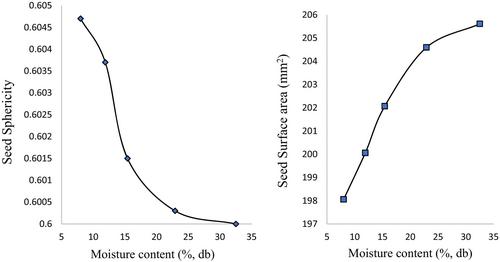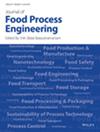Sweetsop seed holds significant economic value as an oil seed, with ca. 25% oil content that finds applications as a feedstock for energy generation. The moisture-modulated thermophysical properties of the seed were determined at varying moisture contents (8.0%–32.5%). Physical properties (length [L], width [W], thickness [T], arithmetic [Amd], and geometric mean diameters [Gmd], sphericity [Sty], surface area [SA], and bulk density [ρd]) were determined using standard methods while the thermal properties (specific heat capacity [SHC], thermal conductivity [Tcd], and thermal diffusivity [Tdf]) were analyzed using a TEMPOS thermal analyzer. The results showed that the seed L, W, T, Amd, and Gmd, Sty, SA, and ρd ranged from 13.22–14.95 mm, 7.32–7.95 mm, 5.25–5.35 mm, 8.60–8.75 mm, and 7.96–8.11 mm, 0.61–0.60, 196.72–205.28 mm2, and 210.00–270.00 kg m−3, respectively. The SHC, Tcd, and Tdf ranged from 0.14–0.52 J kg−1 K−1, 0.17–0.35 W m−1 K−1, and 0.10–0.20 m2 s−1, respectively. The ANOVA results indicated that the thermo-physical properties studied were significantly (p ≤ 0.05) affected by moisture content. By utilizing the determined properties, engineers can develop efficient machines to harness the economic potential of sweetsop seed oil in various industries, including biofuel generation.
The thermal and physical properties of sweetsop seed are needed by agricultural and mechanical engineers and food scientists to explore the potential application of the seed and the seed product, like oil for industrial and commercial purposes. Data obtained on the specific heat capacity of the seed would be valuable in designing of heating compartment of an oil expeller, thermal conductivity and diffusivity would be needed to design drying systems that balance efficiency and quality preservation, facilitate efficient removal of moisture from the seed while minimizing the risk of over-drying or under-drying. Thus, affects the design of the seed storage systems. Data on the seed axial dimensions, sphericity, mean diameters, surface area, and bulk density would be useful in the design and fabrication of agricultural equipment like sheller, grinder, packaging machines, discharge chute, aperture, and planter, to ensure proper seed placement, flow and to determine machine throughput capacity.



